《生物化学》课程PPT教学课件(留学生)Chapter 19 glycolipid metabolism
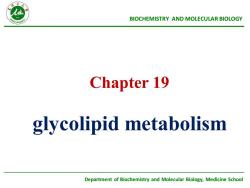
BIOCHEMISTRYANDMOLECULARBIOLOGYChapter 19glycolipid metabolismDepartment of Biochemistry and Molecular Biology,Medicine School
Department of Biochemistry and Molecular Biology, Medicine School BIOCHEMISTRY AND MOLECULAR BIOLOGY Chapter 19 glycolipid metabolism
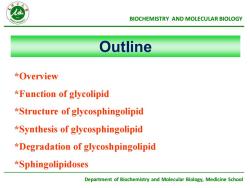
BIOCHEMISTRYANDMOLECULARBIOLOGYOutline*Overview*Function of glycolipid*Structure ofglycosphingolipid*Synthesis of glycosphingolipid*Degradation ofglycoshpingolipid*SphingolipidosesDepartment of Biochemistry and Molecular Biology,Medicine School
Department of Biochemistry and Molecular Biology, Medicine School BIOCHEMISTRY AND MOLECULAR BIOLOGY Outline *Overview *Function of glycolipid *Structure of glycosphingolipid *Synthesis of glycosphingolipid *Degradation of glycoshpingolipid *Sphingolipidoses
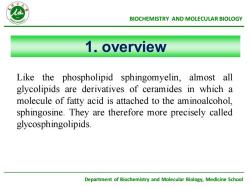
BIOCHEMISTRYANDMOLECULARBIOLOGY1.overviewLike the phospholipid sphingomyelin, almost allglycolipids are derivatives of ceramides in which amolecule of fatty acid is attached to the aminoalcohol.sphingosine. They are therefore more precisely calledglycosphingolipidsDepartment of Biochemistry and Molecular Biology,Medicine School
Department of Biochemistry and Molecular Biology, Medicine School BIOCHEMISTRY AND MOLECULAR BIOLOGY Like the phospholipid sphingomyelin, almost all glycolipids are derivatives of ceramides in which a molecule of fatty acid is attached to the aminoalcohol, sphingosine. They are therefore more precisely called glycosphingolipids. 1. overview
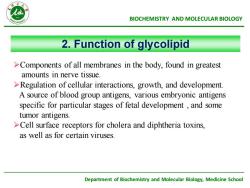
BIOCHEMISTRYANDMOLECULARBIOLOGY2.Functionofglycolipid>Components of all membranes in the body, found in greatestamounts in nerve tissue>Regulation of cellular interactions, growth, and developmentA source of blood group antigens, various embryonic antigensspecific for particular stages of fetal development , and sometumor antigens>Cell surface receptors for cholera and diphtheria toxinsas well as for certain viruses.Department of Biochemistry and Molecular Biology,Medicine School
Department of Biochemistry and Molecular Biology, Medicine School BIOCHEMISTRY AND MOLECULAR BIOLOGY ➢Components of all membranes in the body, found in greatest amounts in nerve tissue. ➢Regulation of cellular interactions, growth, and development. A source of blood group antigens, various embryonic antigens specific for particular stages of fetal development , and some tumor antigens. ➢Cell surface receptors for cholera and diphtheria toxins, as well as for certain viruses. 2. Function of glycolipid
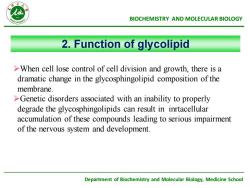
BIOCHEMISTRYANDMOLECULARBIOLOGY2.Functionof glycolipidWhen cell lose control of cell division and growth, there is adramatic change in the glycosphingolipid composition of themembrane.>Genetic disorders associated with an inability to properlydegrade the glycosphingolipids can result in inrtacellularaccumulation of these compounds leading to serious impairmentof the nervous system and development.Department of Biochemistry and Molecular Biology,Medicine School
Department of Biochemistry and Molecular Biology, Medicine School BIOCHEMISTRY AND MOLECULAR BIOLOGY ➢When cell lose control of cell division and growth, there is a dramatic change in the glycosphingolipid composition of the membrane. ➢Genetic disorders associated with an inability to properly degrade the glycosphingolipids can result in inrtacellular accumulation of these compounds leading to serious impairment of the nervous system and development. 2. Function of glycolipid
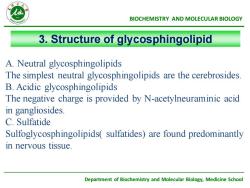
BIOCHEMISTRYANDMOLECULARBIOLOGY3.Structure of glycosphingolipidA.Neutral glycosphingolipidsThe simplest neutral glycosphingolipids are the cerebrosidesB.Acidic glycosphingolipidsThe negative charge is provided by N-acetylneuraminic acidingangliosidesC.SulfatideSulfoglycosphingolipids( sulfatides) are found predominantlyinnervous tissue.Department of Biochemistry and Molecular Biology,Medicine School
Department of Biochemistry and Molecular Biology, Medicine School BIOCHEMISTRY AND MOLECULAR BIOLOGY A. Neutral glycosphingolipids The simplest neutral glycosphingolipids are the cerebrosides. B. Acidic glycosphingolipids The negative charge is provided by N-acetylneuraminic acid in gangliosides. C. Sulfatide Sulfoglycosphingolipids( sulfatides) are found predominantly in nervous tissue. 3. Structure of glycosphingolipid

ARBIOLOGYO-GlycosidicbondCHOHHHHOC-C-C-C-CH2OH1HNHOHOHHH-AWNAAAOECIHOHGalactoseCeramide(polarnead)(hydrophoblcta)Figure17.14Stnucture ofa neutral glyco-sphingoipidgalactccerebrosideisafattyacidhydrocarbonchain).veparunent ui Diucermsury anu iviuiecular Diuugy, iviedicine School
Department of Biochemistry and Molecular Biology, Medicine School BIOCHEMISTRY AND MOLECULAR BIOLOGY
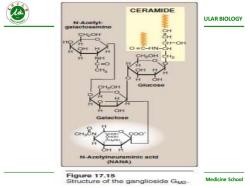
CERAMIDEAULARBIOLOGYN-AcetviEactoamn-舌舌--SH工1GIUCOOHSHOHalectcseAAN-Acetyineuramlinlcacid(NANA)Figure17.15MedicineSchoolStructure of the ganglioside Gm2-
Department of Biochemistry and Molecular Biology, Medicine School BIOCHEMISTRY AND MOLECULAR BIOLOGY
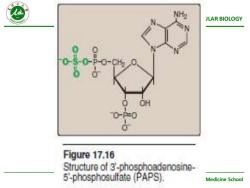
ANHJLARBIOLOGY05-0-P-O-CHOOH0O-P=OOFigure17.16Structureof3'-phosphoadenosine-5'-phosphosulfate(PAPS)Medicine School
Department of Biochemistry and Molecular Biology, Medicine School BIOCHEMISTRY AND MOLECULAR BIOLOGY
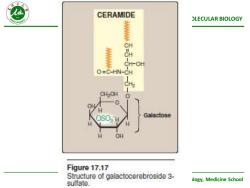
ACERAMIDEDLECULARBIOLOGYAWWO=C-HN-CHCH-OHOn-GalacoseOSOHHHOHFigure17.17Structure of galactocerebroside 3-logy,MedicineSchoolsulfate
Department of Biochemistry and Molecular Biology, Medicine School BIOCHEMISTRY AND MOLECULAR BIOLOGY
按次数下载不扣除下载券;
注册用户24小时内重复下载只扣除一次;
顺序:VIP每日次数-->可用次数-->下载券;
- 《生物化学》课程PPT教学课件(留学生)Chapter 18 phospholipid metabolism.ppt
- 《生物化学》课程PPT教学课件(留学生)Chapter 29 Metabolism of Nucleotides.ppt
- 《生物化学》课程PPT教学课件(留学生)Chapter 20 The metabolism of cholesterol.ppt
- 《生物化学》课程PPT教学课件(留学生)Chapter 31 Structure and Function of RNA.ppt
- 《生物化学》课程PPT教学课件(留学生)Chapter 01 Amino Acids(overview).ppt
- 《生物化学》课程PPT教学课件(留学生)Chapter 01 Amino Acids(structure of amino acid、acid/base properties of amino acid).ppt
- 《生物化学》课程PPT教学课件(留学生)Chapter 14 Metabolism of monosaccharides and disaccharides.ppt
- 《生物化学》课程PPT教学课件(留学生)Chapter 15 glycosaminoglycans.ppt
- 《生物化学》课程PPT教学课件(留学生)Chapter 07 Introduction of Carbohydrates.ppt
- 《生物化学》课程PPT教学课件(留学生)Chapter 21 Amino acids - disposal of nitrogen.ppt
- 《生物化学》课程PPT教学课件(留学生)Chapter 06 Bioenergetics and Oxidative Phosphorylation.ppt
- 《生物化学》课程PPT教学课件(留学生)Chapter 22 Amino acids - metabolism of carbon skeletons.ppt
- 《生物化学》课程PPT教学课件(留学生)Chapter 33 Molecular Basis of Inherited Disease.ppt
- 《生物化学》课程PPT教学课件(留学生)Chapter 09 Tricarboxylic Acid Cycle.ppt
- 《生物化学》课程PPT教学课件(留学生)Chapter 10 Gluconeogenesis.ppt
- 《生物化学》课程PPT教学课件(留学生)Chapter 28 Vitamins.ppt
- 《生物化学》课程教学资源(文献资料)Lehninger Principles of Biochemistry,5th EDITION,David L. Nelson、Michael M. Cox.pdf
- 《生物化学》课程教学资源(文献资料)临床医本考试大纲.doc
- 《生物化学》课程教学资源(文献资料)临床医本实验大纲 Biochemistry Experiment.doc
- 《生物化学》课程教学资源(文献资料)实验教程.doc
- 《生物化学》课程PPT教学课件(留学生)Chapter 32 Biosynthesis of Protein.ppt
- 《生物化学》课程教学资源(PPT课件)18 维生素 Vitamins.ppt
- 《生物化学》课程教学资源(PPT课件)16 血液的生物化学 Hemal Biochemistry.ppt
- 《生物化学》课程教学资源(PPT课件)17 肝的生物化学 Biochemistry in Liver.ppt
- 《生物化学》课程PPT教学课件(留学生)Chapter 30 DNA Structure and Replication.ppt
- 《生物化学》课程教学资源(PPT课件)13 基因表达调控 Regulation of Gene Expression.ppt
- 《生物化学》课程教学资源(PPT课件)15 信号转导(细胞信息传递 Cell Communication and Signal Transduction).ppt
- 《生物化学》课程教学资源(PPT课件)14 基因重组与基因工程 Genetic Recombination and Genetic Engineering.ppt
- 《生物化学》课程教学资源(PPT课件)09 物质代谢的联系与调节 Metabolic Interrelationships and Regulation.ppt
- 《生物化学》课程教学资源(PPT课件)12 蛋白质的生物合成 Biosynthesis of Protein(翻译).ppt
- 《生物化学》课程教学资源(PPT课件)11 RNA的生物合成 RNA Biosynthesis(转录 transcription).ppt
- 《生物化学》课程教学资源(PPT课件)10 DNA的生物合成(复制).ppt
- 《生物化学》课程教学资源(PPT课件)07 氨基酸代谢 Metabolism of Amino Acids.ppt
- 《生物化学》课程教学资源(PPT课件)06 生物氧化 Biological Oxidation.ppt
- 《生物化学》课程教学资源(PPT课件)05 脂类代谢 Metabolism of Lipid.ppt
- 《生物化学》课程教学资源(PPT课件)08 核苷酸代谢 Metabolism of Nucleotides.ppt
- 《生物化学》课程教学资源(PPT课件)03 酶 Enzyme.ppt
- 《生物化学》课程教学资源(PPT课件)04 糖代谢 Metabolism of Carbohydrates.ppt
- 《生物化学》课程教学资源(PPT课件)01 蛋白质的结构与功能 The structure and function of protein.ppt
- 《生物化学》课程教学资源(PPT课件)02 核酸的结构与功能.ppt
